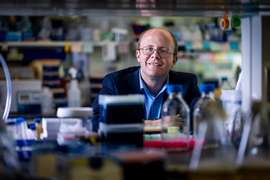At any given time, millions of T cells circulate throughout the human body, looking for potential invaders. Each of those T cells sports a different T cell receptor, which is specialized to recognize a foreign antigen.
To make it easier to understand how that army of T cells recognizes their targets, MIT Associate Professor Michael Birnbaum has developed tools that can be used to study huge numbers of these interactions at the same time.
Deciphering those interactions could eventually help researchers find new ways to reprogram T cells to target specific antigens, such as mutations found in a cancer patient’s tumor.
“T-cells are so diverse in terms of what they recognize and what they do, and there's been incredible progress in understanding this on an example-by-example basis. Now, we want to be able to understand the entirety of this process with some of the same level of sophistication that we understand the individual pieces. And we think that once we have that understanding, then we can be much better at manipulating it to positively affect disease,” Birnbaum says.
This approach could lead to improvements in immunotherapy to treat cancer, as well as potential new treatments for autoimmune disorders such as type 1 diabetes, or infections such as HIV and Covid-19.
Tackling difficult problems
Birnbaum’s interest in immunology developed early, when he was a high school student in Philadelphia. His school offered a program allowing students to work in research labs in the area, so starting in tenth grade, he did research in an immunology lab at Fox Chase Cancer Center.
“I got exposed to some of the same things I study now, actually, and so that really set me on the path of realizing that this is what I wanted to do,” Birnbaum says.
As an undergraduate at Harvard University, he enrolled in a newly established major known as chemical and physical biology. During an introductory immunology course, Birnbaum was captivated by the complexity and beauty of the immune system. He went on to earn a PhD in immunology at Stanford University, where he began to study how T cells recognize their target antigens.
T cell receptors are protein complexes found on the surfaces of T cells. These receptors are made of gene segments that can be mixed and matched to form up to 1015 different sequences. When a T cell receptor finds a foreign antigen that it recognizes, it signals the T cell to multiply and begin the process of eliminating the cells that display that antigen.
As a graduate student, Birnbaum worked on building tools to study interactions between antigens and T cells at large scales. After finishing his PhD, he spent a year doing a postdoc in a neuroscience lab at Stanford, but quickly realized he wanted to get back to immunology.
In 2016, Birnbaum was hired as a faculty member in MIT’s Department of Biological Engineering and the Koch Institute for Integrative Cancer Research. He was drawn to MIT, he says, by the willingness of scientists and engineers at the Institute to work together to take on difficult, important problems.
“There's a fearlessness to how people were willing to do that,” he says. “And the community, particularly the immunology community here, was second to none, both in terms of its quality, but also in terms of how supportive it was.”
Billions of targets
At MIT, Birnbaum’s lab focuses on T cell-antigen interactions, with the hope of eventually being able to reprogram those interactions to help fight diseases such as cancer. In 2022, he reported a new technique for analyzing these interactions at large scales.
Until then, most existing tools for studying the immune system were designed to allow for the study of a large pool of antigens exposed to one T cell (or B cell), or a large pool of immune cells encountering a small number of antigens. Birnbaum’s new method uses engineered viruses to present many different antigens to huge populations of immune cells, allowing researchers to screen huge libraries of both antigens and immune cells at the same time.
“The immune system works with millions of unique T cell receptors in each of us, and billions of possible antigen targets,” Birnbaum says. “In order to be able to really understand the immune system at scale, we spend a lot of time trying to build tools that can work at similar scales.”
This approach could enable researchers to eventually screen thousands of antigens against an entire population of B cells and T cells from an individual, which could reveal why some people naturally fight off certain viruses, such as HIV, better than others.
Using this method, Birnbaum also hopes to develop ways to reprogram T cells inside a patient’s body. Currently, T cell reprogramming requires T cells to be removed from a patient, genetically altered, and then reinfused into the patient. All of these steps could be skipped if instead the T cells were reprogrammed using the same viruses that Birnbaum’s screening technology uses. A company called Kelonia, co-founded by Birnbaum, is also working toward this goal.
To model T cell interactions at even larger scales, Birnbaum is now working with collaborators around the world to use artificial intelligence to make computational predictions of T cell-antigen interactions. The research team, which Birnbaum is leading, includes 12 labs from five countries, funded by Cancer Grand Challenges. The researchers hope to build predictive models that may help them design engineered T cells that could help treat many different diseases.
“The program is put together with a focus on whether these types of predictions are possible, but if they are, it could lead to much better understanding of what immunotherapies may work with different people. It could lead to personalized vaccine design, and it could lead to personalized T cell therapy design,” Birnbaum says.










